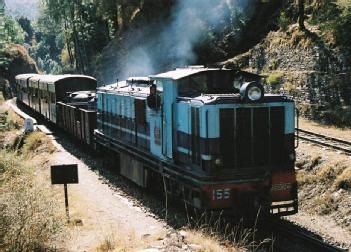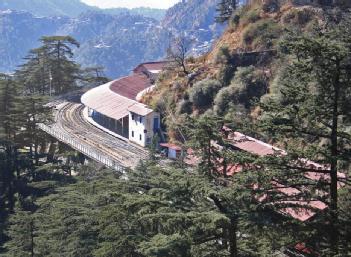
Kalka-Shimla Railway |
133302 Kalka, India (Haryana) |
|
| Address |
|
| Floor area | unfortunately not known yet |
Railway
- World Heritage Site
|
Opening times
|
see: shimla-travel.com/shimla_railway.shtml | ||||
|
Status from 08/2014
|
We don't know the fees. | ||||
| Contact |
|
||||
| Homepage |
www.shimla-travel.com/shimla_railway.shtml www.shimlaonline.in/city-guide/shimla-railway-station |
||||
| Location / Directions |
RailKalka railway station is the northern terminal of the Delhi-Kalka line of Northern Railway, Indian Rail (Station code KLK) serving as terminal station for broad gauge line (towards Chandigarh) and narrow gauge line (towards Shimla). Direct trains on broad gauge, connect to Delhi, Mumbai, Howrah etc.Important Trains Between Delhi and KalkaTrain Name: Himalayan QueenTrain No.: 4095 Train Name: Shatabdi Express Train No.: 2011 Train Name: Shatabdi Express Train No.: 2005 Train Name: Kalka Mail Train No.: 2311 RoadKalka is situated along a slope. This makes it somewhat difficult to commute on foot. Local transport (within Kalka) is by shared auto-rickshaws. These autos ply to a distance of around 15–20 km. There are also shared cabs (not the luxury ones) for distances up to 25–30 km. Government and private buses are also very common for commuting to nearby towns. Many intercity govt buses start or pass through Kalka, connecting it with Chandigarh, Ambala, Delhi, Shimla and many other cities. |
| Description | The Kalka-Shimla Railway was built in the year 1903. The railway line is one of the highest railway lines of the world and is located at an altitude of 2076 m. RouteThe Kalka–Shimla Railway was built to connect Shimla, the summer capital of India during the British Raj, with the Indian rail system. Now, Shimla is the capital city of Himachal Pradesh and Kalka is a town in the Panchkula district of Haryana. Spectacular scenery along the whole route, and the marvels of its construction, keeps the traveler on this line spell bound. On leaving Kalka, 656 meters (2,152 ft) above sea level, the railway enters the foothills and immediately commences its climb. TunnelsOriginally 107 tunnels were built on Kalka Shimla Railway Track. In 1930 they were renumbered and four of them were discarded so only 103 were left. In 2006 tunnel number 46 was dismantled so presently only 102 are in use. But tunnel number 103, the last tunnel in Shimla, is still famous as tunnel number 103 as this place has become a famous landmark of the town. InfrastructureThe line has 864 bridges, one of which is an 18.29 metre (60 ft) plate girder span and steel truss. The others are viaducts with multi-arched galleries like the ancient Roman aqueducts. Bridge No. 493, historically known as the "Arch Gallery", situated between Kandaghat and Kanoh stations, is an arch bridge in three stages, constructed with stone masonry. Bridge No. 226; between Sonwara and Dharampur is an arch gallery bridge having 5 tier galleries of multiple spans, constructed with stone masonry and bridging a deep valley surrounded by high peaks. LocomotivesToday this line is operated with class ZDM-3 diesel-hydraulic locomotives (522 kW, 50 km/h), built 1970 to 1982 by Chittaranjan Locomotive Works with a single cab road switcher body. Six locomotives of the same class were built in 2008/2009 by Central Railway Loco Workshop Parel with updated components and a dual cab body providing better visibility of the track. Kalka–Shimla0 km Kalka |
[dsp_museum_detail.cfm]
| Data Compliance | More Information |
 shimla-travel.com
shimla-travel.com 




